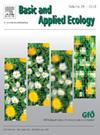景观组成对半自然草原无脊椎食草动物对开花植物的影响
IF 3.5
2区 环境科学与生态学
Q2 ECOLOGY
引用次数: 0
摘要
景观尺度的土地利用对驱动物种群落和相互作用具有重要意义。然而,尽管人们越来越关注昆虫减少的生态后果,但我们对物种丰富的半自然栖息地中不同土地覆盖类型的相对比例如何影响昆虫食草性的理解仍然有限。本研究评估了瑞典南部18个半自然草地上47种开花草本植物的叶、茎和花的食草性,并通过可耕地作物、森林、莱草和永久草地的比例量化了周围的景观组成。除了景观效应外,我们还研究了植物性状、植物多样性和群落组成的中介作用,以更好地了解土地利用如何影响草食。永久草地和可耕地比例对草食的影响最大。随着永久草地比例的增加和耕地作物比例的减少,叶、茎类草食的发生概率增加。对于草食强度,叶片咀嚼损害表现出最显著的响应,其变化趋势与草食发生相似,而花的损害强度随永久草地比例的增加而增加,随森林比例的增加而降低。这些影响在物种水平上不太一致,具有不同的响应幅度和方向。植物群落组成和植物高度、比叶面积(SLA)等性状介导了景观组成对嚼叶食草性的影响,即高的比叶面积和高的植物与耕地作物的比例相关,而高的比叶面积又促进了嚼叶食草性。我们的研究结果强调了在景观尺度上保护永久性草地对于维持当地半自然草地开花植物昆虫食草水平的重要性,并呼吁更好地了解农业景观中食草减少对生态系统的影响。本文章由计算机程序翻译,如有差异,请以英文原文为准。
Landscape composition influences invertebrate herbivory on flowering forbs in semi-natural grasslands
Landscape-scale land use is important in driving species communities and interactions. However, despite increasing concerns regarding the ecological consequences of insect declines, our understanding of how the relative proportions of different land cover types influence insect herbivory in species-rich semi-natural habitats remains limited. This study assessed leaf, stem, and flower herbivory across 47 flowering forb species in 18 semi-natural grassland sites in southern Sweden, where the surrounding landscape composition was quantified by the proportions of arable crops, forests, leys, and permanent grasslands. In addition to landscape effects, we examined the mediating roles of plant traits, plant diversity, and community composition to better understand how land use affects herbivory. Proportion of permanent grasslands and arable crops had the strongest influence on herbivory. The occurrence probabilities of leaf and stem herbivory increased as the proportion of permanent grasslands increased and the proportion of arable crops decreased. For herbivory intensity, leaf chewing damage exhibited the most significant response, following a trend similar to herbivory occurrence, while flower damage intensity increased with proportion of permanent grasslands but decreased with proportion of forest. These effects were less consistent at the species level, with varying magnitudes and directions of response. Plant community composition and traits, such as plant height and Specific Leaf Area (SLA), mediated landscape composition effects on leaf chewing herbivory, such that the proportion of arable crops were linked to higher SLA and taller plants, which in turn promoted leaf chewing herbivory. Our findings highlight the importance of preserving permanent grasslands at the landscape scale for maintaining insect herbivory levels on flowering forbs in local semi-natural grasslands, and call for the need to better understand the ecosystem consequences of reduced herbivory in agricultural landscapes.
求助全文
通过发布文献求助,成功后即可免费获取论文全文。
去求助
来源期刊

Basic and Applied Ecology
环境科学-生态学
CiteScore
6.90
自引率
5.30%
发文量
103
审稿时长
10.6 weeks
期刊介绍:
Basic and Applied Ecology provides a forum in which significant advances and ideas can be rapidly communicated to a wide audience. Basic and Applied Ecology publishes original contributions, perspectives and reviews from all areas of basic and applied ecology. Ecologists from all countries are invited to publish ecological research of international interest in its pages. There is no bias with regard to taxon or geographical area.
 求助内容:
求助内容: 应助结果提醒方式:
应助结果提醒方式:


